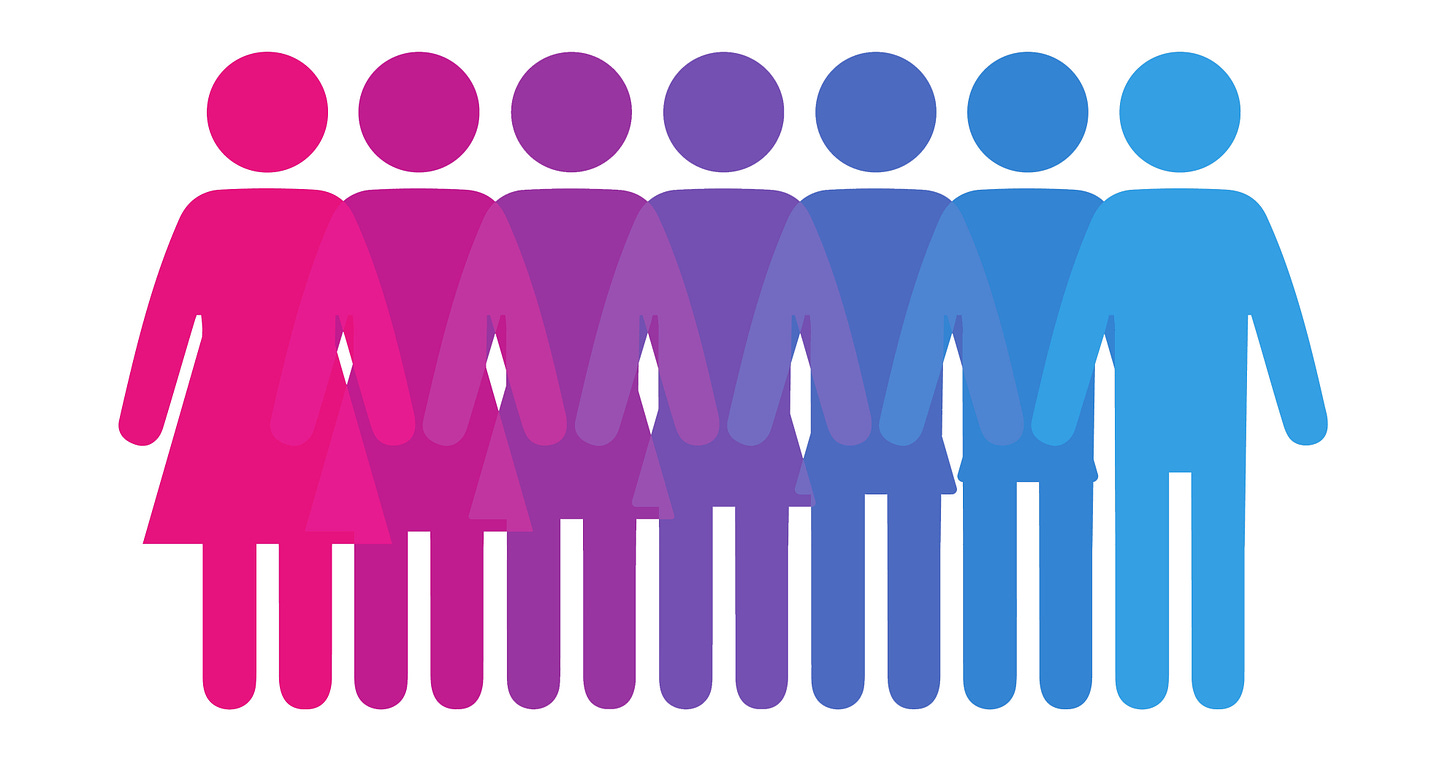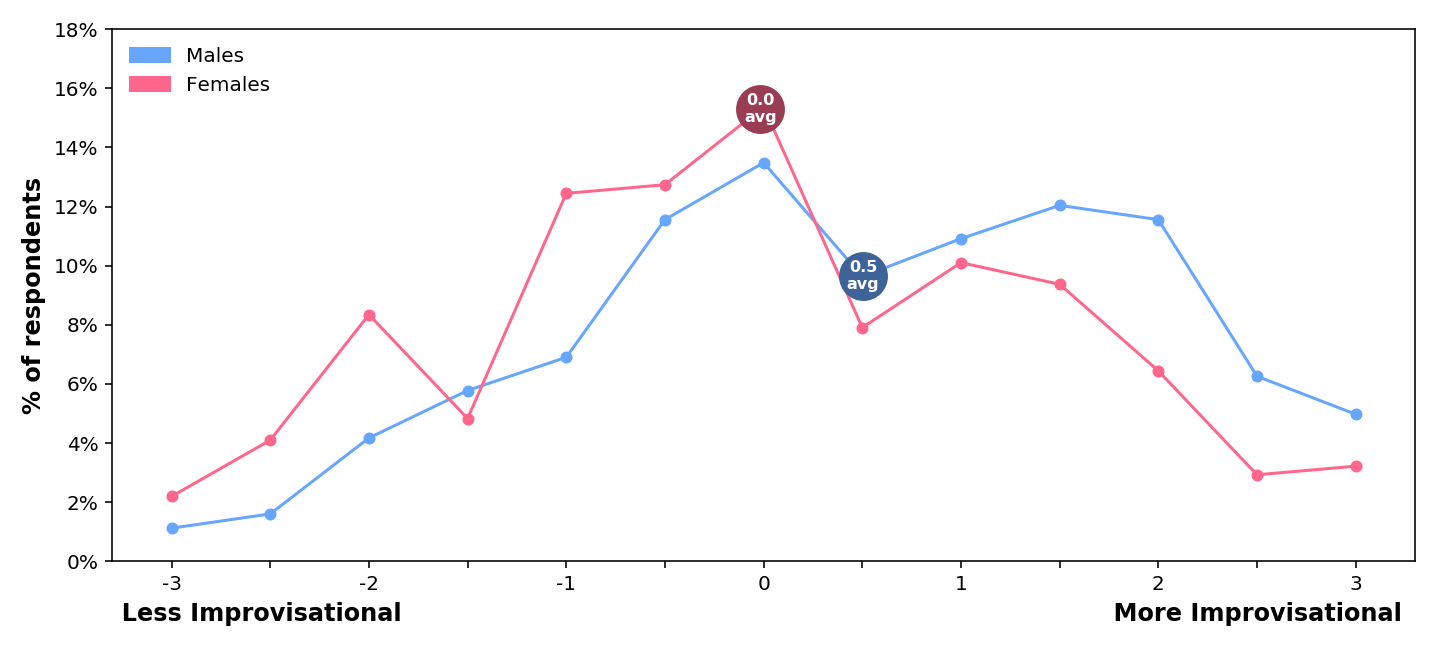Multiple people have been tripped up by my claims in the previous post that “they/them pronouns are never correct pronouns for a person whose sex isn’t ambiguous” and “demanding that people call you by incorrect pronouns counts as bullying and harassment.” This post addresses the first of these two.
First, I posit that there are infinite genders, and there are only four sexes. If you already agree with either of these statements, feel free to skip to the punchline.
1. There Are Infinite Genders
Gender itself is a new-ish concept. Before the previous century, that word related primarily to linguistic rules about words. A thing that fussy grammar nazis tutted about. “Sex” described animals, “gender” described words. One of the biggest catalysts for the change in meaning of “gender” was Ruth Bader Ginsburg. When arguing sex discrimination cases before the US Supreme Court in the 1970s, she switch from “sex discrimination” to “gender discrimination,” because apparently people couldn’t stay serious in a long conversation that included the word “sex” over and over.
Let’s pause to think about that. We often ridicule British Victorians for being so uptight about sex that they wouldn’t say the word “leg” and would put little pants on the legs of their pianos so they wouldn’t be exposed (Not true, but a commonly repeated story nonetheless). And yet, in the highest court of the land, the most serious judges and lawyers of their generation couldn’t stay focused if the word “sex” was dropped repeatedly. So much so that it endangered legislation effecting half the population, and this was patched by RBG tabooing the word entirely and swapping in a grammatical construct! (sure, this was a trend already, but RBG popularized it)
Anyway.
At first gender was just a substitute word for sex, so it came in two flavors. But over the decades, it’s come to mean the way someone identifies in personality, and presents in public. The neat thing about that is that everyone has a different personality!
Clearer Thinking has a Gender Continuum Test you can take. The test is short and fun. The real gold is in the analysis afterwards. The whole thing is really great, and I cannot recommend it enough. Go, play with it, you’ll be glad you did. :)
I’m about to lift a whole bunch of stuff directly from the post-test analysis, I hope they don’t mind.
We examined over 600 different personality questions looking for differences.
We were not able to find even a single personality trait where there was a large difference in the average score of men and women
The biggest correlation we found between gender and any one personality trait was r=0.42. [… if] you tried to guess that person’s gender using just that score, you’d mispredict that person’s gender 31% of the time! Women are actually closer to the male average in this trait 37% of the time (i.e. they are more typically male than typically female in this trait). So that means that if there is a room of 100 women, about 37 of them will be closer to the average male score than they are to the average female score!
And remember, that was the personality trait that we found to be most predictive of gender. All the other traits that had an association with gender had a substantially weaker relationship.
Across all these personality traits, women were closer to the female average than the male average only 61% of the time, and men were closer to the male average than the female average only 57% of the time. In other words, it’s extremely common for men to have quite a number of these “more female” traits, and for women to have quite a number of these “more male” traits. [emphasis added]
Only about 1% of males and 1% of females had almost entirely “more male” or almost entirely “more female” personality traits!
Take a look at the last two lines again. Nearly 40% of women and over 40% of men are closer to the average of the opposite sex than their own sex. And only 1% of each matched their sex’s average on almost all traits.
Gender is a spectrum (or continuum, if you prefer). There’s almost limitless manifestations of it. In fact, it can change over one’s lifetime, or even over a day, as one’s mood changes. I took this test today, and also several months ago, and my answers were largely similar, but didn’t quite line up. One was pretty significantly different. Personality is affected by many things, including shit that happened to you recently. Everyone is genderfluid, to some extent.
This is one reason I don’t particularly care to know anyone’s gender. It’s superfluous information, and honestly, sometimes people lie about it in order to present what they think is more socially desirable. Everyone is subject to Social Desirability Bias to some degree, and I don’t feel any compelling reason to amplify this.
Also it’s more fun to find out the old fashioned way.
2. There Are Only Four Sexes
If you are alive, you had two genetic parents. One of them was born as one of the traditional sexes (Male or Female), and the other was born as the other.
Image taken from Reality’s Last Stand. See below.
Until recently, basically all humans could be catagorized as one of the two traditional sexes. There isn’t any other option. Colin Wright is an evolution biologist who writes at Reality’s Last Stand (again, some direct lifts, hope he doesn’t mind)
males are the sex that produce small gametes (sperm) and females produce large gametes (ova). There are no intermediate gametes, which is why there is no spectrum of sex. Biological sex in humans is a binary system.
It is crucial to note, however, that the sex of individuals within a species isn’t based on whether an individual can actually produce certain gametes at any given moment. Pre-pubertal males don’t produce sperm, and some infertile adults of both sexes never produce gametes due to various infertility issues. Yet it would be incorrect to say that these individuals do not have a discernible sex, as an individual’s biological sex corresponds to one of two distinct types of evolved reproductive anatomy (i.e. ovaries or testes) that develop for the production of sperm or ova, regardless of their past, present, or future functionality.
A human’s biology is organized on a deep level around whether it developed to produce ova or sperm. Deviations from this are extremely rare, and the deviations aren’t a different sex, they are almost exclusively disorders of one of the two sexes. (But still very valuable persons!)
Or at least, that used to be the case.
With the power of modern technology, we have some measure of morphological freedom! Through years of hormone replacement, multiple surgeries, and a lot of physical training, we can mostly switch someone’s sex to the opposite sex. It’s not quie perfect… due to the limits of current technology, we can’t reforge every developmental path traveserd since early gestation. Certain physical difference are still unalterable, or can only be partially corrected. Continued medical intervention remains necessary. So the person can’t be fully catagorized as identical to their new sex. Nonetheless, the level of change is so drastic that they clearly are not the old sex anymore either.
We have created two new sexes, in the image of the old sexes. Trans Male and Trans Female, we created them.
3. Pronous Refer To Sex — Not Gender — By Necessity
In English, the third-person singular pronouns for humans match observed sex. It didn’t have to be this way, the fact that they match observed sex are an ancient linguist artifact. But that is how it works in English, and this is literally why trans people want to be addressed with the pronouns of their new sex.
I recently came upon fascinating speculation regarding the possible origin of this. “Pronoun Collision” is the problem of a pronoun being ambiguous and thus useless (or even actively confusing.)
If you wanted more pronoun-classes to reduce the probability of collisions … you could devise some other system that doesn’t bake sex into the language while driving the collision rate even lower than that of the sex-based system—like using initials to form pronouns (Katherine put ker book on its shelf?), or an oral or written analogue of spatial referencing in American Sign Language (where a signer associates a name or description with a direction in space, and points in that direction for subsequent references).
The speculation is that sex-based pronouns are a natural Schelling point of ways to reduce pronoun collision, since sex is binary and easy to observe.
one might speculate that “more classes to reduce collisions” could be part of the historical explanation for grammatical gender, in conjunction with the fact that sex is binary and easy to observe. None of the other most salient features of a human can quite accomplish the same job: age is continuous rather than categorical; race is also largely continuous (clinal) and historically didn’t typically vary within a tribal/community context.
Indeed, sex is binary, making for a great Schelling point to avoid such collision. Even the two new sexes are mirrors of the two natal sexes.
Gender is not binary. Gender is the opposite of binary. It isas vast and diverse as the entire human population. Each gender is unique and deserves a unique label. Fortunately we already have labels that match up to the infinite genders of everyone, and those labels are people’s names. In fact, names have an advantage as high-resolution identifiers, because names are fairly stable. A gender can change from day to day or hour to hour.
Pronouns are a simplification. That is their whole point. They are low-resolution by design. Some languages have pronouns so low-resolution that they only have a single set of third-person singular pronouns, with no sex identification. There are languages of even lower resolution that don’t have a separate set for singular vs plural pronouns!
In the other direction, there are languages with additional pronoun sets for higher levels of resolution. Some have sets for formal vs informal relationships (English used to have this in the “thou/you” distinction). Some languages have inclusive vs exclusive “we” pronouns (“we (and you)” vs “we (but not you)”). Some languages have different pronoun sets to differentiate animate vs inanimate objects. There’s even languages that have pronouns that differentiate the owner of an object!
4. What Does This Have To Do With They/Them Pronouns?
…
This post is long! To read the rest of it, go to my substack. I’m slowly transitioning over to there, and this is one nudge to switch over. The whole thing is up for free, as is everything I’ve ever blogged about.





